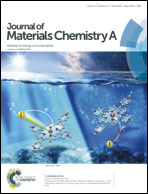Structural evolution during sodium deintercalation/intercalation in Na2/3[Fe1/2Mn1/2]O2†
Abstract
Among the various possible earth abundant electrode materials, P2-Na2/3[Fe1/2Mn1/2]O2 is one of the most promising cathode materials for sodium ion batteries. Most transition metal oxide materials undergo various structural transitions during the sodiation/desodiation process and it is crucial to understand such transitions for further development of these materials. In the present research, in situ X-ray diffraction (XRD), in situ Raman spectroscopy and ex situ solid-state Nuclear Magnetic Resonance (NMR) were used as tools to understand such transitions for the specific case of P2-Na2/3[Fe1/2Mn1/2]O2. Both in situ Raman spectroscopy and X-ray diffraction measurements, together with ex situ solid-state NMR studies revealed that the synthesized P2-Na2/3[Fe1/2Mn1/2]O2 hexagonal crystal structure undergoes P2–OP4 reversible phase transitions at the end of the charge process and at the end of the discharge process a biphasic mechanism follows. Moreover, ex situ solid state NMR measurements revealed the fast diffusion of Na+ ions in the 2D layers of P2-Na2/3[Fe1/2Mn1/2]O2, which led to an average 23Na NMR signal that reflects very accurately the average oxidation state of the metal centres. Solid state NMR data also shows that the diffusion of sodium ions is frozen at high levels of sodiation, at low voltages and that at the end of the charge process the prismatic coordinated sites are preferentially populated in the OP4 phase.
![Graphical abstract: Structural evolution during sodium deintercalation/intercalation in Na2/3[Fe1/2Mn1/2]O2](/en/Image/Get?imageInfo.ImageType=GA&imageInfo.ImageIdentifier.ManuscriptID=C4TA06360K&imageInfo.ImageIdentifier.Year=2015)

 Please wait while we load your content...
Please wait while we load your content...